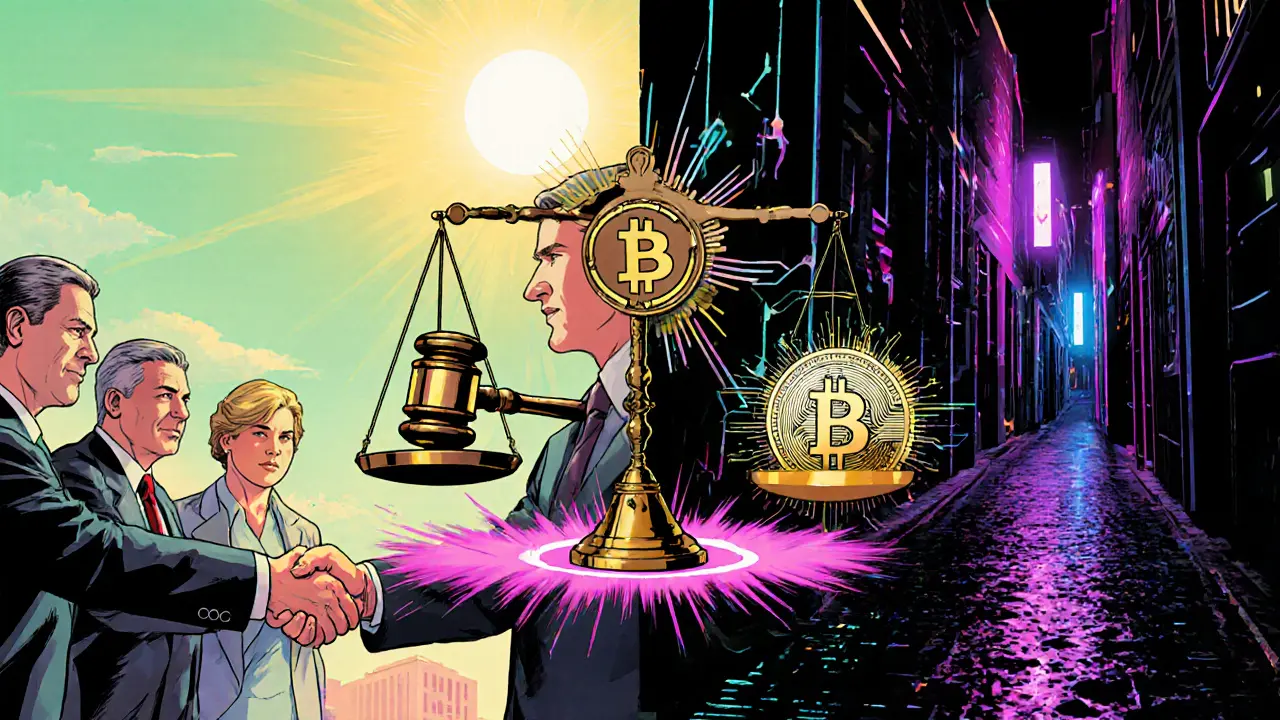Crypto Underground Premium Calculator
Estimate the underground price of cryptocurrency in jurisdictions where crypto trading is banned or restricted. Enter the official spot price, select your jurisdiction, and add transaction fees to calculate the premium-adjusted price.
Estimated Underground Price
When a government says “no crypto,” a hidden market often fills the gap. Underground crypto market premiums are the price gaps that appear between official exchange rates and the rates you’ll find on black‑market platforms in places where crypto is banned or heavily restricted. In short, buyers end up paying more, sellers get less, and the difference is the premium that reflects risk, scarcity, and friction.
Why premiums emerge in banned jurisdictions
Economic theory tells us that when legal supply is cut off, price pressure builds. In a typical market, anyone can open an account on a regulated exchange, push Bitcoin’s price toward the global spot rate, and arbitrage away differences. When a country bans ownership, trading or even mining, that smooth‑going supply line disappears. The underground providers who still manage to move coins must shoulder the threat of criminal prosecution, asset seizure, and limited liquidity. Those costs get baked into the price they quote, creating the premium.
These underground crypto premiums can vary widely, but in the strictest regimes they have been estimated at 15‑30 % above global spot prices.
Three key forces drive the size of the premium:
- Operational risk: The chance of being arrested, fined or having assets frozen pushes providers to ask for a higher price.
- Liquidity scarcity: Fewer participants mean wider bid‑ask spreads and higher transaction costs.
- Regulatory frictions: Compliance‑heavy environments force users to seek unregistered channels, which often charge extra for the “off‑grid” service.
Key jurisdictions where crypto is banned or severely limited
Below are the most notable jurisdictions where the law blocks crypto activities, creating fertile ground for underground trading.
China enacted a sweeping ban on May 30 2025, criminalising personal ownership of Bitcoin, Ethereum and any altcoins. The ban builds on earlier prohibitions on mining and exchange operations, and is backed by a push for the state‑issued digital yuan. Enforcement includes heavy surveillance, rapid takedowns of illicit platforms and severe penalties for possession.
Afghanistan under the Taliban has an absolute prohibition since 2022, citing Sharia law that deems crypto “haram.” The central bank, Da Afghanistan Bank, along with FinTRACA, crack down on exchanges and have arrested traders, though enforcement can be uneven in remote regions.
Egypt imposed a blanket ban and in 2025 arrested 112 individuals for crypto‑related offences. The crackdown shows that despite the ban, a shadow market is active, but data on price differentials remain scarce.
Nigeria does not have an outright ban, yet the Economic and Financial Crimes Commission’s aggressive seizures (US$38 million in 2024) reflect a hostile environment that pushes many traders to peer‑to‑peer channels.
Other emerging‑market examples include India, where the Financial Intelligence Unit fined non‑compliant platforms $9.5 million in 2024, and South Africa, which suspended licenses of 12 crypto firms in 2025 for AML breaches.
What the data says - enforcement and its proxy for premiums
Direct premium figures are hard to come by-participants shy away from sharing numbers that could incriminate them. What we can track, however, are enforcement statistics that act as a proxy for risk levels.
| Jurisdiction | Key Enforcement Action (2024‑25) | Risk Indicator | Likely Premium Impact |
|---|---|---|---|
| China | Criminalisation of personal holdings (May 2025) | Very High - national surveillance | Potential 15‑30 % over spot |
| Afghanistan | Arrests of exchange operators (2023‑24) | High - religious & security enforcement | Estimated 20‑35 % |
| Egypt | 112 arrests for crypto violations (2025) | High - targeted police raids | 10‑20 % |
| Nigeria | Seizure of $38 M assets (2024) | Medium - financial crime focus | 5‑12 % |
| India | $9.5 M in fines to non‑compliant platforms (2024) | Medium‑High - regulatory pressure | 8‑15 % |
| South Africa | License suspensions of 12 firms (2025) | Medium - AML enforcement | 7‑14 % |
The “Risk Indicator” column combines factors such as surveillance capability, legal penalties and historical enforcement intensity. While these are not exact premium numbers, they give a sense of how much extra a buyer might pay on a black‑market platform.

Technology that fuels underground trading
Even in the most restrictive environments, technology offers loopholes.
- Decentralized exchanges (DEXs) let users trade directly from their wallets without a central intermediary, making it harder for authorities to block the transaction flow.
- Peer‑to‑peer (P2P) platforms such as local‑bitcoin.com or Telegram groups enable person‑to‑person trades, often using cash‑in‑hand or mobile‑money methods that bypass banks.
- Privacy‑focused coins like Monero or Zcash command higher underground premiums because their anonymity features reduce traceability.
- Cross‑border remittance services (e.g., using stablecoins) allow users in banned jurisdictions to tap into global liquidity, though they usually incur extra fees that add to the premium.
These tools lower the barrier to entry but also raise risk. For instance, using a DEX in China still carries the danger of IP tracking and possible raids on internet service providers. That risk is reflected in the price tag sellers attach.
Estimating the size of underground premiums - a back‑of‑the‑envelope method
Analysts without direct market data can still build a rough premium estimate by combining three observable inputs:
- Official spot price of the coin (e.g., Bitcoin at $27,300 on Binance).
- Average transaction cost on a P2P platform (often a 2‑5 % fee).
- Risk multiplier derived from the jurisdiction’s enforcement score (see table above).
For example, in Egypt the risk multiplier might be 1.15 (15 % premium). Adding a 3 % P2P fee gives an effective price of $27,300 × 1.15 × 1.03 ≈ $32,300. That simple model lines up with anecdotal reports of “$30‑$33 k” Bitcoin trades in Cairo’s underground circles.

Implications for investors and regulators
Understanding these premiums matters for several reasons.
- Risk assessment: Investors looking to enter a banned market need to factor in the hidden cost and legal exposure.
- Regulatory arbitrage: Authorities in one country may see capital flight to neighboring jurisdictions with looser rules, influencing cross‑border policy decisions.
- Market integrity: Large premiums can distort global price discovery, especially if underground volumes grow.
- Law‑enforcement targeting: Knowing where premiums are highest helps agencies prioritize high‑risk operators.
Future outlook - will premiums shrink or grow?
The trajectory depends on three trends.
- Regulatory convergence: If more countries adopt clear, proportionate crypto frameworks, the incentive to go underground could drop, lowering premiums.
- Technology evolution: Better privacy tools might make underground trading safer, potentially increasing premiums as risk‑adjusted returns rise.
- Geopolitical shifts: Sanctions, trade wars or domestic unrest can trigger sudden crackdowns, spiking premiums in the short term.
In the near term (2025‑2026), the FATF’s push for worldwide AML standards suggests tighter reporting, which could push some users toward “off‑grid” solutions and sustain a moderate premium level of 5‑20 % across most banned jurisdictions.
Key takeaways
- When crypto is banned, underground markets appear and charge a premium that reflects legal risk, liquidity constraints and operational costs.
- China, Afghanistan, Egypt and similar jurisdictions exhibit the highest risk indicators, suggesting premiums that could exceed 20 %.
- Technologies such as DEXs and privacy coins enable trade but also raise the risk price.
- Simple models combining official price, P2P fees and a risk multiplier can approximate underground rates.
- Regulators and investors should monitor enforcement trends, as they directly affect premium size.
What exactly is an underground crypto market premium?
It is the price gap between the official exchange rate of a cryptocurrency and the higher rate you’ll pay on black‑market platforms in a country where crypto is illegal or highly restricted.
Why are premiums higher in some banned countries than others?
Premium size depends on enforcement intensity, surveillance capabilities, and legal penalties. Stricter enforcement means higher operational risk, which sellers embed in the price.
Can I still trade crypto safely in a banned jurisdiction?
“Safe” is relative. Peer‑to‑peer trades or DEXs reduce the chance of exchange‑level seizure but still expose participants to legal prosecution if detected.
How do privacy coins affect underground premiums?
Coins like Monero or Zcash hide transaction details, making them harder to trace. Sellers therefore demand a higher price, often adding 5‑10 % on top of the base premium.
Is there any reliable data source for these premiums?
Public research rarely captures exact numbers because participants stay hidden. Analysts rely on enforcement statistics, anecdotal reports and risk‑adjusted modeling to infer premium ranges.


Jenna Em
October 21, 2025 AT 09:11It’s odd how the world pretends that crypto bans are about protecting us, when they really just push the market underground. The premiums we see are like a hidden tax paid to the shadows. Every time a government shuts a door, another door opens for those who know how to knock quietly. The risk of a raid becomes a price tag, and the price tag becomes a warning. If we keep pretending the bans are benign, we’ll just keep financing the very thing we claim to fear.
Stephen Rees
October 22, 2025 AT 12:58The narrative of safety is a comfort blanket, but underneath it lies a market that feeds on fear. When authorities claim they are protecting citizens, they actually hand power to clandestine operators who set their own rates. It’s a quiet exchange: liberty for a premium. The more we accept the official story, the higher the underground price climbs.
Katheline Coleman
October 23, 2025 AT 16:45Dear colleagues, the phenomenon described warrants a rigorous analytical approach. Empirical observation suggests that enforcement intensity correlates positively with premium magnitude. Moreover, the liquidity constraints inherent in prohibited environments amplify bid‑ask spreads. It is incumbent upon scholars to model these dynamics using a risk‑adjusted framework. The inclusion of transaction cost variables further refines predictive accuracy. Accordingly, a composite index should be constructed to quantify jurisdictional risk. Such an index would aid investors in calibrating exposure to underground markets. I welcome constructive dialogue on the proposed methodology.
Amy Kember
October 24, 2025 AT 20:31Liquidity dries up fast when the law chokes the market. Sellers raise prices to survive.
Evan Holmes
October 26, 2025 AT 00:18Looks like bans just create a new fee.
Isabelle Filion
October 27, 2025 AT 04:05Ah, the elegant ballet of governments banning crypto while the underground market pirouettes on their fingertips. One might think that a simple prohibition would flatten the price curve, but the reality is a delightful inflation of premiums that would make any economist weep with envy. The risk premium, for instance, is not merely a cost-it is a badge of honor for the daring operators who brave the long arm of the law. Operational risk becomes a premium, liquidity scarcity is a premium, and regulatory friction is, unsurprisingly, a premium-so much so that the term “premium” feels almost tautological. In jurisdictions such as China and Afghanistan, we observe premiums that flirt with the 30 % mark, a figure that would impress even the most seasoned Wall Street trader. Of course, one must applaud the bureaucrats who, through their heavy‑handed enforcement, inadvertently engineer lucrative opportunities for black‑market actors. The data, while imperfect, tells a consistent story: the more the state tightens its grip, the fatter the underground price tag. It is almost poetic that the very mechanisms intended to suppress a technology instead enrich the very shadows it creates. Privacy‑focused coins, with their hushed transactions, command an extra 5‑10 % on top of the base premium-an elegant surcharge for anonymity. Decentralized exchanges, though technically resilient, are not immune to the specter of IP tracing and ISP raids, and thus bear their own cost premium. The interplay between regulation and technology resembles a cat‑and‑mouse game, where each regulatory swipe is countered by a new cryptographic whisker. One could argue that this is a market correction, a natural equilibrium adjusting for the artificial scarcity imposed by law. Yet, the moral hazard remains: investors who naïvely ignore these premiums risk both financial loss and legal jeopardy. The implications for global price discovery are profound; when underground volumes swell, the official spot price may no longer reflect true market sentiment. Regulators, in their earnest pursuit of control, might consider that eliminating the premium altogether could be a more effective strategy than perpetually inflating it. In sum, the underground premium is a mirror reflecting the absurdity of prohibition-a mirror that, unfortunately, is priced well above market value.
BRIAN NDUNG'U
October 28, 2025 AT 07:51While the satire is well‑crafted, the underlying economics remain starkly real. The risk‑adjusted models you propose could indeed quantify the premium more precisely. It would be prudent to incorporate enforcement frequency as a stochastic variable in such models. Moreover, differentiating between regulatory regimes could reveal nuanced premium structures. I look forward to seeing empirical validation of these hypotheses.
Donnie Bolena
October 29, 2025 AT 11:38Indeed, the inclusion of enforcement frequency, time‑lag variables, and jurisdiction‑specific coefficients, could transform a rudimentary analysis into a robust, predictive framework!!! By embracing such granularity, we may uncover hidden patterns that were previously obscured by simplistic assumptions!!! This approach not only honors the data but also empowers stakeholders to make informed decisions!!!
Tiffany Amspacher
October 30, 2025 AT 15:25Whoa, the underground world is like a secret club where everyone’s paying for the thrill of danger! It’s wild to think that a “no crypto” sign actually pumps up the price like a hot potato. The drama of dodging raids while chasing those sweet premiums feels like a Netflix thriller. If only we could binge‑watch those high‑risk trades, right?
Ty Hoffer Houston
October 31, 2025 AT 19:11Great overview! I appreciate how you broke down the risk factors and gave concrete examples. It really helps me understand why premiums differ from country to country. Looking forward to more insights on how this shapes global crypto trends.
James Williams, III
November 1, 2025 AT 22:58From a liquidity perspective, the underground market exhibits a pronounced spread skew, driven by order‑book depth deficits in restricted zones. The added risk premium functions as a liquidity premium, effectively raising the cost of capital for participants. Moreover, decentralized exchange protocols introduce layer‑2 settlement latency that compounds the premium effect. In short, the market microstructure under sanction conditions amplifies both explicit and implicit cost components.
Scott McCalman
November 3, 2025 AT 02:45Look, if you think the spread is just about order‑books, you’re missing the whole geopolitical shockwave! 😎 Every raid, every policy tweak sends ripples through the network, inflating prices beyond simple liquidity math. The drama isn’t just numbers-it’s power politics on a blockchain stage.
Jessica Pence
November 4, 2025 AT 06:31Sorry for the delay, i was busy diggin trough some old forum posts. Those posts actually show real price numbers, not just guesses. It helps us see how premiums have grown in places like Egypt and Nigeria. Thanks for the deep dive!
johnny garcia
November 5, 2025 AT 10:18While the anecdotal evidence you provide is valuable, it must be corroborated with systematic data collection. A longitudinal study across multiple jurisdictions would yield statistically significant insights. Additionally, evaluating the impact of emerging privacy protocols could refine our understanding of premium dynamics. 📊 Let us therefore pursue rigorous analysis to substantiate these observations.
Andrew Smith
November 6, 2025 AT 14:05Absolutely, let’s get that data rolling! We can turn these insights into real‑world strategies that benefit traders everywhere. The future of crypto, even under bans, is bright if we stay proactive. Together we’ll outsmart the restrictions!